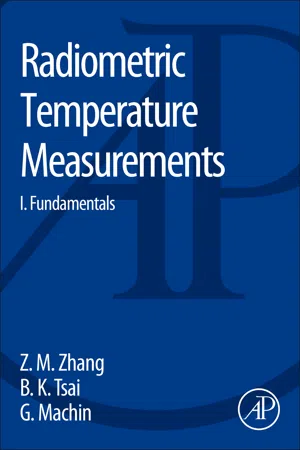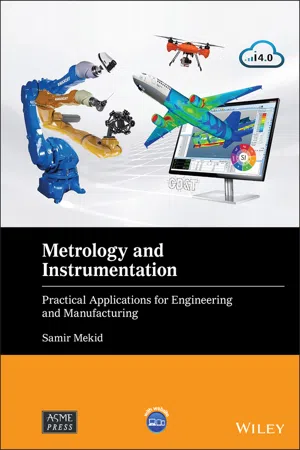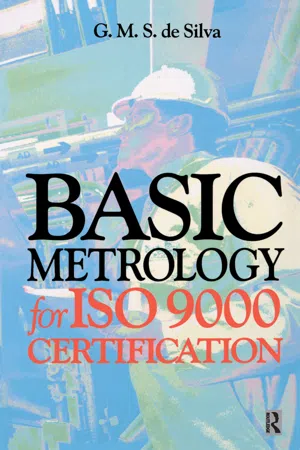Technology & Engineering
Thermometry
Thermometry is the science of measuring temperature. It involves the use of various instruments and techniques to quantify thermal energy. Thermometers, thermocouples, and infrared sensors are commonly used in thermometry to accurately determine temperature in a wide range of applications, from industrial processes to medical diagnostics.
Written by Perlego with AI-assistance
Related key terms
Related key terms
1 of 4
Related key terms
1 of 3
6 Key excerpts on "Thermometry"
- eBook - ePub
Radiometric Temperature Measurements
I. Fundamentals
- (Author)
- 2009(Publication Date)
- Academic Press(Publisher)
The important point here is that a temperature could be defined either through classical thermodynamics or by statistical mechanics. One of the triumphs of physics in the 19th century was that it brought the two fields into one unified theoretical framework, showing that the temperature parameters that appeared in the two formalisms are exactly equivalent.2.1.3. SummaryFrom the seemingly disparate disciplines of classical thermodynamics and statistical mechanics, there emerged the same unique system parameter, thermodynamic temperature, T, leading to the prospect of deriving a universally applicable temperature scale to replace the arbitrary schemes which had previously been used. The determination of thermodynamic temperature by primary Thermometry and the current definition of the kelvin are the subject of the next section.2.2. Primary Thermometry methods
Primary Thermometry is temperature measurement where the equation of state of a well-defined physical system can be explicitly written down and used, or where a rigorous physical relationship exists between temperature and the measured physical property of the sensor. For example, the equation of state of a gas or the relationship between the mean-square noise voltage across a resistor and temperature is well known and can be used for accurate Thermometry, albeit with considerable difficulty. In contrast, neither the expansivity of mercury in glass nor the resistivity of platinum as function of temperature is well known from first principles, and thermometers using these properties must be calibrated before use. This section briefly outlines some of the primary methods of Thermometry which have been used in recent years [1] and [9] .2.2.1. Constant-volume gas ThermometryConstant-volume Thermometry is based on the equation of state for an ideal gaswhere p is the pressure, V the fixed volume, n the number of moles of gas in V, R the molar gas constant and T the thermodynamic temperature. In principle, this is a very simple method: for a known amount of gas in a known and constant volume, and given the value for R, a measurement of pressure can be used to determine the temperature. In practice, ratios of pressures are used to determine ratios of temperatures, starting from a known reference temperature such as the triple point of water. In this way, the gas density n/V can be eliminated from the equation, to first order of accuracy. Even so the experiments are difficult, for many practical reasons to do with sensing and measuring the pressure, the constancy of the volume and density, adsorption or desorption of the gas in the bulb and sensing tube, etc. A comprehensive list of factors that introduce uncertainties into constant-volume gas Thermometry are given in Ref. [9] and discussed in detail in Ref. [1](1) - Myer Kutz, Myer Kutz(Authors)
- 2015(Publication Date)
- Wiley(Publisher)
CHAPTER 14
TEMPERATURE MEASUREMENT
PETER R. N. CHILDSSummary 14.1 Introduction 14.1.1 The measurement process 14.1.2 Calibration 14.2 Selection 14.3 Invasive temperature measurement 14.3.1 Liquid-in-glass thermometers 14.3.2 Manometric Thermometry 14.3.3 Bimetallic thermometers 14.3.4 Thermocouples 14.3.5 Resi stance temperature devices 14.3.6 Semiconductor devices 14.3.7 Diode thermometers 14.3.8 Noise Thermometry 14.3.9 Pyrometric cones 14.4 Semi-invasive methods 14.4.1 Peak temperature-indicating devices 14.4.2 Temperature-sensitive paints 14.4.3 Thermographic phosphors 14.4.4 Thermochromic liquid crystals 14.5 Noninvasive methods 14.5.1 Infrared Thermometry 14.5.2 Thermal imaging 14.6 Conclusions Nomenclature ReferencesSUMMARY
The requirement to measure temperature arises in process control, production, environmental observation, and laboratory research. The range of techniques available for measuring temperature is extensive. Many phenomena are dependent on temperature and this can be exploited in instrumentation. A given application may permit direct contact between a measuring device or system and the medium of interest. Alternatively, remote observation of, for example, infrared radiation or fluorescence may be possible using an optical system. This chapter outlines various forms of invasive, semi-invasive, and noninvasive temperature measurement devices and systems. In addition, this chapter describes the fundamental definitions of temperature and the issues that need to be considered in determining the temperature of a given medium, be it a solid body, surface, liquid, or gas.14.1 INTRODUCTION
Temperature can be defined qualitatively as a measure of hotness of a body. Temperature is the property that determines whether a system is in thermal equilibrium with other systems. If the temperature of two bodies in thermal contact with each other is same, then there will be no net transfer of thermal energy. Quantitatively, temperature can be defined from the second law of thermodynamics in terms of the rate of change of entropy with energy.- Ketil Motzfeldt(Author)
- 2012(Publication Date)
- Wiley(Publisher)
3 Temperature MeasurementsPreamble
This chapter deals with an important subject. To quote from the preface in the textbook of McGee (1988):During a scientific career as an engineering professor I have observed that the most common mistake a scientist makes is to accept a temperature reading without question. The scientific literature is full of papers about otherwise fine research that is based on temperature measurements of uncertain quality.In the years since McGee wrote this, his own book, and a number of other textbooks that have appeared, have hopefully led to an improved situation. Some of the books are mentioned specifically at the end of this chapter, otherwise they are included in the general list of references. The present text represents an attempt to cover part of the same material within a more limited frame and restricted to high temperature measurements.For practical reasons, Chapter 3 covers only methods using a solid sensor in contact with the hot object (in particular thermocouples) while radiation pyrometry is treated in Chapter 4.3.1 Fundamentals of Temperature Measurement
3.1.1 The Concept of Temperature
From early childhood we experience the difference between hot and cold, or in other words, differences in temperature. The concept is familiar, and yet it is not easy to define.What is Temperature?
A partial answer is given by Zemansky (1964): Temperature is a property of matter . Other partial definitions have been tried. For instance, if two bodies A and B are in thermal contact with no heat flux between them, the two are at the same temperature. This is sometimes referred to as the zeroth law of thermodynamics, but it is not very informative.We will attempt another approach, considering the concept of energy .Generally, energy is equivalent to work or anything that may be converted into work. We note that each form of energy may be written as the product of an intensive factor and an extensive- eBook - ePub
Metrology and Instrumentation
Practical Applications for Engineering and Manufacturing
- Samir Mekid(Author)
- 2021(Publication Date)
- Wiley-ASME Press Series(Publisher)
In contrast to basic standards such as length and mass, temperature is measured by indirect comparison. To determine temperature, a standardized calibrated device is required. Various primary effects causing temperature changes can be used to measure temperature, such as variations in physical or chemical conditions, electrical properties, radiation ability, or physical dimensions. The temperature signal has a response affected by:- Level of thermal conductivity and heat capacity of the element and the fluid surrounding the element;
- Coefficient of heat transfer of the film;
- Surface area per unit mass;
- Mass velocity of the hosting fluid.
- Thermal expansion where the materials exhibit a change in size with change in temperatures;
- The changes of the electrical resistance of a conductor;
- Thermoelectric technique mostly known as thermocouples;
- Radiative temperature measurement.
- Thermocouples with all types;
- Pressure thermometers;
- Liquid‐in‐glass thermometers;
- Bimetallic strip thermometers;
- Resistance temperature detectors (RTDs);
- Thermistors.
For noncontact‐type sensors, we measure the radiant power of the infrared or optical radiation received by the object. Instruments such as radiation or optical pyrometers determine the temperature; the noncontact‐type sensors include:- Fiber‐optic thermometers;
- Radiation pyrometers;
- Optical pyrometers.
11.7 Temperature Measured through Thermal Expansion Materials
Liquid‐in‐glass thermometer.Figure 11.211.7.1 Liquid‐in‐Glass Thermometer
Temperature can be measured basically by the thermal expansion of a liquid. Example is the liquid‐in‐glass (LiG) thermometer. A LiG thermometer possesses a glass capillary tube inside a stem with a liquid‐filled bulb at one end. - eBook - ePub
- G. M. S. de Silva(Author)
- 2012(Publication Date)
- Routledge(Publisher)
7
Measurement oftemperature
7.1 Introduction
Temperature is one of the most important measurement parameters from an industrial point of view. Large numbers of temperature measuring instruments such as mercury-in-glass thermometers, dial thermometers, thermocouple sensors, resistance temperature devices (RTDs) and temperature transmitters are used in most industrial systems. It is also an important parameter in health services, for monitoring of the environment and safety systems.7.2 SI units
The SI base unit for temperature is the kelvin, defined as the fraction 1/273.16 of the thermodynamic temperature of the triple point of water. The degree Celsius is also recognized in the SI system and is defined by the relation:(7.1) where t is a temperature in degrees Celsius and T is the equivalent kelvin temperature.7.3 Thermodynamic scale
Temperature is the degree of hotness of an object and is governed by the laws of thermodynamics. The temperature scale based on the first and second laws of thermodynamics is known as the thermodynamic temperature scale. The lowest limit of the thermodynamic scale is absolute zero or 0 kelvin (K). Since the scale is linear by definition only one other non-zero reference point is needed to establish its slope. This reference point was originally defined as the freezing point of water (0°C or 273.15 K). In 1960 the reference point was changed to a more precisely reproducible point, namely the triple point of water (0.01 °C).However, measurement of temperature on the thermodynamic scale is hardly suitable for practical Thermometry. In practice there are three main reasons: (a)It is difficult to measure thermodynamic temperatures. Apart from the technical elaboration required it could take days if not weeks to measure a single thermodynamic temperature. - eBook - ePub
- Kaveh Azar(Author)
- 2020(Publication Date)
- CRC Press(Publisher)
5.4.4 Transient vs. steady-state measurements 5.4.4.1 Situations in which the same solid-state junction device is used for heat input and Thermometry 5.4.4.2 Situations in which it is desirable to learn something about the location of various components of the thermal resistance 5.4.4.3 Transient applications 5.5 Summary 5.6 For further study 5.7 Defining terms References5.1 Introduction
Temperature measurement plays an important role in determining and measuring the heat transfer characteristics of an electronic system. The basic problem or situation we are trying to understand is how large a temperature excursion will be produced for a given power input from the integrated circuits (ICs) or other active devices in the electronic system. In general, the input power to the system can be measured very accurately. However, measurement of temperatures in the devices or other parts of the system depends on both the nature of the thermometer or thermal sensor as well as the specific conditions under which the measurement is to be made. This temperature measurement problem is the subject of this chapter.We have an intuitive idea of what the concept of temperature is and of how it is measured. From childhood we have observed thermometers and felt what it is like to be hot or cold. However, in experimentally studying heat transfer in complex systems, it is useful to have a solid foundation in the more quantitative concepts of temperature and to know how it can be measured using various types of thermometers or, more generally, temperature sensitive devices. Electronic devices or systems involve many complex materials such as glass-epoxy printed circuit boards, moving air, pumped fluids, and integrated circuits with localized heat sources. The measurement of temperature in each of the above materials involves use of special thermometers or thermal transducers and special techniques.
Index pages curate the most relevant extracts from our library of academic textbooks. They’ve been created using an in-house natural language model (NLM), each adding context and meaning to key research topics.
Explore more topic indexes
Explore more topic indexes
1 of 6
Explore more topic indexes
1 of 4





